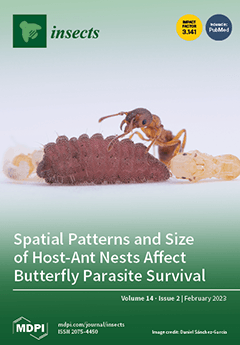The olfactory system plays a key role in various insect behaviors, and odorant-binding proteins participate in the first step of the olfactory process.
Ophraella communa Lesage is an oligophagous phytophagous insect that is a specific biological control agent for
Ambrosia artemisiifolia L. The
[...] Read more.
The olfactory system plays a key role in various insect behaviors, and odorant-binding proteins participate in the first step of the olfactory process.
Ophraella communa Lesage is an oligophagous phytophagous insect that is a specific biological control agent for
Ambrosia artemisiifolia L. The leaf beetle must identify and locate
A. artemisiifolia through olfaction; however, its odorant-binding protein (OBP) function has not yet been reported. In this study,
OcomOBP7 was cloned, and its tissue expression profile and binding ability were analyzed using RT-qPCR and fluorescence binding assays, respectively. Sequence analysis demonstrated that
OcomOBP7 belongs to the classical OBP family. The RT-qPCR results showed that
OcomOBP7 was specifically expressed in the antennae, indicating that
OcomOBP7 may be involved in chemical communication. The fluorescence binding assay showed that
OcomOBP7 has an extensive binding ability to alkenes. The electroantennography experiments showed that
O. communa antennal response to α-pinene and ocimene decreased significantly after interference because the two odors specifically bound to
OcomOBP7. In summary, α-pinene and ocimene are odorant ligands corresponding to
OcomOBP7, indicating that
OcomOBP7 is involved in the chemical recognition of
A. artemisiifolia. Our study lays a theoretical foundation for research into
O. communa attractants, which is helpful for the better biological control of
A. artemisiifolia by
O. communa.
Full article






